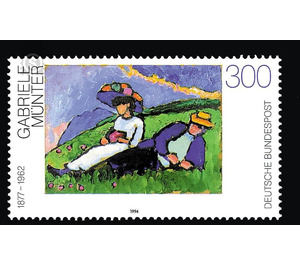German painting of the 20th century (3) - Germany / Federal Republic of Germany 1994 - 300 Pfennig
Theme: Art & Culture
| Country | Germany / Federal Republic of Germany |
| Issue Date | 1994 |
| Face Value | 300.00 |
| Color | multi-colored |
| Perforation | K 13 3/4: 14 |
| Printing Type | Multicolor offset printing |
| Stamp Type | Postage stamp |
| Item Type | Stamp |
| Chronological Issue Number | 1623 |
| Chronological Chapter | GER-BRD |
| SID | 209816 |
| In 28 Wishlists | |
One year after the creation of Heckel's painting, in 1911, the »Blaue Reiter«, the second important artistic community of the early avant-garde, formed in Munich. Alongside Wassily Kandinsky and Franz Marc, Gabriele Münter (1877-1962) was one of the founding members. As early as 1909, the small-format oil painting was created, showing artist friends Alexej Jawlensky and Marianne Werefkin on a meadow near Murnau and later becoming one of Münter's most famous works. The small village of Murnau am Staffelsee in the Bavarian Alpine foothills, which Münter and Kandinsky discovered a year earlier, became the home of the Munich Art Circle. Here, in the seclusion of simple, rural life, Gabriele Münter managed a sovereign use of the modern painterly means, which are characterized by a radical simplification of form, a flat conception of the motives and by strong contrasts of almost unmixed colors. The depicted figures are not portrayed portraitually, but taken as simple basic forms in a cloisonné of stable black contours. Gabriele Münter took up elements of popular stained glass that inspired the artists around Kandinsky. In addition to this, he explored the painting of Paul Gauguin and Henri Matisse, who received special support from Jawlensky, who had been in Paris in 1907. (Text: Martina Padberg, M.A., Bonn)


